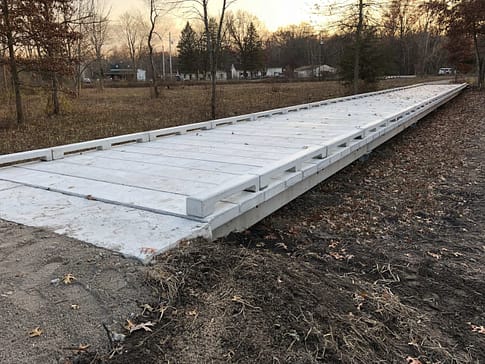As communities expand and invest in public spaces, the need for durable, sustainable infrastructure has never been clearer. Parks, wetlands, coastal areas, and urban greenways are turning to modern boardwalk systems that balance environmental sensitivity with long-term performance. Among the most compelling solutions is the concrete boardwalk—a low-maintenance, eco-friendly alternative to traditional wooden walkway designs.
The Problem with Traditional Wooden Walkways
For decades, wooden walkways and bridges were the default choice for trails and waterfront access. But these structures often demand frequent repairs or full replacements due to rot, insect damage, and weathering. This leads to increased lifecycle costs, environmental impact from treated lumber, and disruptions to natural habitats during repeated maintenance.
This is why many municipalities, parks departments, and developers are prioritizing wooden walkway replacement with more resilient materials.
The Advantages of Concrete Boardwalk Systems
Modern concrete boardwalk systems offer several key advantages:
- Durability: Concrete resists rot, insects, UV exposure, and heavy foot traffic, dramatically reducing maintenance costs over decades of use.
- Environmental Sensitivity: Modular designs can be installed with minimal site disturbance, protecting wetlands and other sensitive ecosystems.
- Customization: Concrete can be cast in forms that mimic wood grain, stone, or other natural finishes, preserving the aesthetic appeal visitors expect while providing superior longevity.
- Sustainability: Many manufacturers use recycled materials and design for longevity, reducing the carbon footprint over the structure’s lifecycle.
Concrete pedestrian bridges and boardwalks are increasingly the go-to solution for trail connectors, coastal access points, and urban parks looking to offer safe, attractive, and accessible routes for all visitors.
Meeting Modern Design and Accessibility Standards
Today’s infrastructure projects must balance function, safety, accessibility, and aesthetics. Concrete boardwalk systems excel here by supporting ADA compliance with smooth, level surfaces and the structural capacity to accommodate handrails and edge protections.
For pedestrian bridges, concrete construction provides both strength and design flexibility. Concrete pedestrian bridges can be built in various spans and styles, suiting both urban settings and natural landscapes without sacrificing durability.
Why Choose Concrete Wall Panels for Supporting Structures
Beyond walkways and bridges, many park and trail projects require retaining walls or decorative barriers. Concrete wall panels offer a consistent, durable solution that can integrate seamlessly with boardwalk systems. They provide erosion control, slope stabilization, and visual cohesion across the project site.
Building for the Future
Communities today want infrastructure that lasts generations, not just years. By investing in high-quality concrete solutions—boardwalk systems, pedestrian bridges, and wall panels—designers and planners are creating safer, more sustainable outdoor spaces that require less maintenance and protect the environment.
If you’re planning a new trail system, urban park, or waterfront redevelopment, consider upgrading from traditional wooden walkways to modern concrete boardwalk systems. Your community—and the environment—will benefit for decades to come.
Interested in learning more? TerraTread specializes in the design and manufacture of advanced concrete boardwalk systems, pedestrian bridges, and concrete wall panels engineered for longevity, beauty, and minimal environmental impact.



